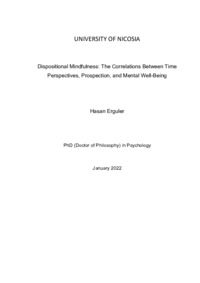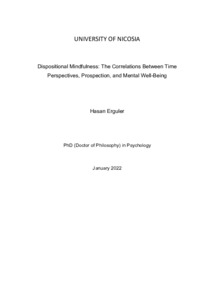-
Background: There is a limited body of empirical research looking into the relationships between dispositional mindfulness (DM) and time perspectives (TPs), regardless of the substantial body of evidence highlighting their importance for mental well-being in separate lines of research. Given the status of limited empirical research encompassing the two constructs simultaneously, it is also important to note the absence of any systematic review, to date, that focuses on organizing such empirical work. Cognitions focused on evaluating possible future events and imagining those, i.e. prospective thoughts and imagery, have also been documented to relate positively to mental wellbeing. Similar to the case with TP literature, empirical studies focusing on DM and prospective cognitions within a grounded working model have been scarce. Given the importance of prospection with regards to mental well-being, and the extant body of literature highlighting mindfulness as a very important contributor to mental health, it becomes even more vital to investigate the possible relations and interactions between these two constructs through empirically grounded and informative working models.
Objectives: Developing from the status of background literature briefly stated, the following thesis aimed at: i) introducing a systematic review for the growing empirical literature on the relationship between mental well-being, DM, and TP; ii) examining the possible links between DM and prospective risk assessments of possible future events in predicting identifiers of psychological distress (Study II: Empirical Paper I); and finally, iii) examining the relations between DM and prospective imagery vividness ratings within the context of psychological distress (Study III: Empirical Paper II).
Results: The systematic review identified a close link between DM and a balanced time perspective (BTP), related to a tendency of flexibility in focusing time domains that which also relates to supporting mental well-being. Mindful presence and non-judgment of experiences in the present moment did appear to be frequently associated, and nonreactivity of inner experience as well as mindful acceptance related to reported optimism on any time domain. Empirical Paper I revealed significant relations between DM, prospective thoughts, and mental well-being indicators; however, failed to identify any interaction effect between DM and prospective thoughts in influencing well-being. Empirical Paper II highlighted an interaction effect between negative imagery vividness ratings and nonreactivity to inner experience facet of DM (F(1,103)=4.00, R2 change=.018, p<.05), the moderating variable, in predicting indicators of psychological distress – albeit being on the edge of statistical significance.
Conclusion: Regarding the relationship between TPs and DM, future studies are advised to incorporate experimental and longitudinal settings to identify causal links that relate to promoting mental well-being. Several promising constructs, including self-compassion and the Carpe Diem (CD) perspective, are highlighted as important points of primary attention. The empirical studies underscored the links between prospective thoughts, prospective imagery vividness, and DM in relating to mental well-being; and proposed a moderating effect for DM on prospective imagery vividness. Future studies are advised to recruit larger samples and rely on the experimental design to follow up on the proposed correlative evidence.
Dispositional Mindfulness: The Correlations Between Time Perspectives, Prospection, and Mental Well-Being
- PhD thesis
-
- Social science -- Psychology



